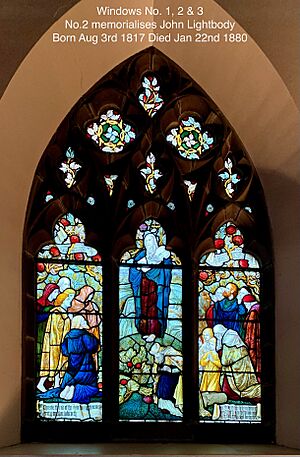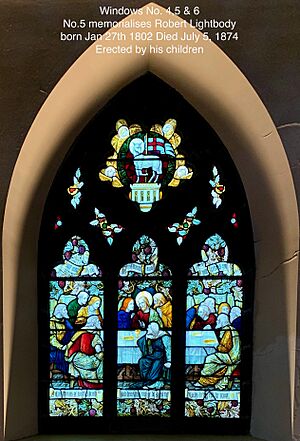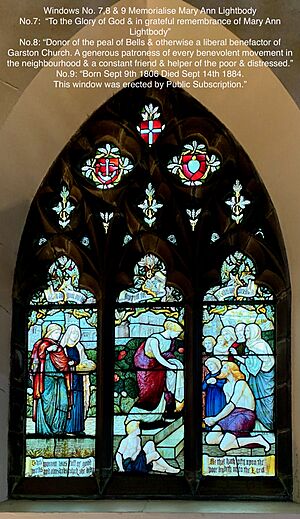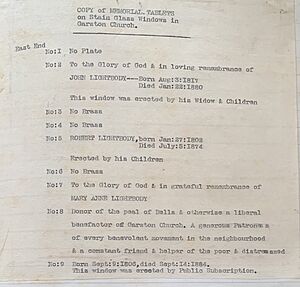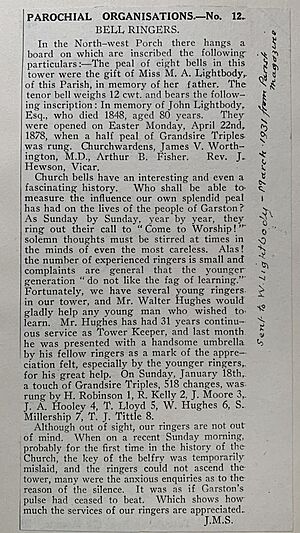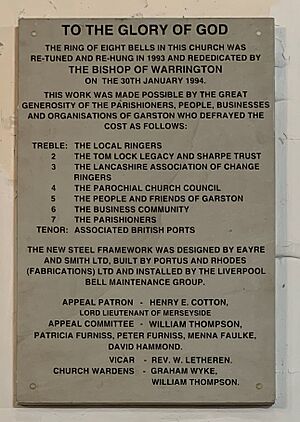St Michael's Church, Garston facts for kids
Quick facts for kids St Michael's Church, Garston |
|
|---|---|
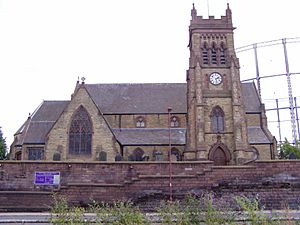
St Michael's Church, Garston, from the north
|
|
| Lua error in Module:Location_map at line 420: attempt to index field 'wikibase' (a nil value). | |
| OS grid reference | SJ 404,843 |
| Location | Church Road, Garston, Merseyside |
| Country | England |
| Denomination | Anglican |
| Website | St Michael, Garston |
| History | |
| Status | Parish church |
| Architecture | |
| Functional status | Active |
| Heritage designation | Grade II |
| Designated | 19 June 1985 |
| Architect(s) | Thomas D. Berry and Son |
| Architectural type | Church |
| Style | Gothic Revival |
| Groundbreaking | 1875 |
| Completed | 1877 |
| Specifications | |
| Materials | Sandstone, slate roofs |
| Administration | |
| Parish | Garston |
| Deanery | Liverpool South Childwall |
| Archdeaconry | Liverpool |
| Diocese | Liverpool |
| Province | York |
St Michael's Church is a beautiful old church located in Garston, a part of Liverpool, England. It's an active Anglican parish church, meaning it's still used for services today. This church is very special because it's listed as a Grade II building. This means it's an important historical site. You can find it on Church Road, right next to some industrial areas and a railway.
Contents
A Look Back in Time
The very first church here was built a long, long time ago in 1225. Another church was built in 1715. The church you see today was built between 1875 and 1877. It was designed by a father and son team, Thomas D. Berry and Son. The church has special ties to the Norris and Watt families from Speke Hall.
Church Design and Features
Outside the Church
St Michael's Church is built from strong, yellow sandstone. It has red stone decorations and slate roofs. The church has a main area called a nave with high windows, and smaller sections on the sides called aisles. There's also a porch on the south side. It has transepts, which are like arms sticking out from the main body. The chancel is the area near the altar, and it has a rounded end called an apse. There are also small chapels.
The church has a tall tower on the northwest side. This tower has strong corner supports called buttresses. It has an entrance on the north side with fancy carvings. Above this entrance is a window with two sections. Higher up, you can see clock faces on three sides. There are also three openings for bells. The top of the tower has a decorative band, a ledge, and gargoyles. It finishes with a parapet that looks like castle walls.
At the west end of the church, there's a large window with three sections. It has beautiful stone patterns called tracery. Along the sides of the aisles and the upper windows, there are windows with two sections. The windows in the transepts have four sections, and those in the chapels have three. The chapel and the porch have pointed roofs.
Inside the Church
Inside the church, the reredos (a screen behind the altar) has special panels. These panels are made with colorful pieces of stone and glass, like a mosaic. All around the church, you can see the Stations of the Cross. These are a series of pictures or carvings that tell a story. They were designed by May L. G. Cooksey.
The windows in the chancel have beautiful stained glass. These windows were made in 1886 by a company called Shrigley and Hunt. The church used to have a two-manual pipe organ built by Franklin Lloyd. A new, larger organ was put in by Rushworth and Dreaper in 1938. It was updated again by the same company in 1967.
Beautiful Stained Glass Windows
The church has nine amazing stained glass windows. Five of these windows remember members of the Lightbody family. They are located at the east end of the church, behind the altar.
- The second window from the left remembers John Lightbody (1817-1880).
- The fifth window remembers Robert Lightbody (1802-1874). His children put it there.
- The seventh window remembers Mary Ann Lightbody (1806-1884).
- The eighth window talks about Mary Ann Lightbody being a generous person. She gave the church its bells and helped many people.
- The ninth window says it was put up by public donations.
John, Robert, and Mary Ann were children of John Lightbody (1767-1848) and Harriet Hughes. Robert Lightbody was known for his work in geology. He studied rocks and fossils.
The Church Bells
St Michael's Church has a set of eight bells. They were made by John Warner & Sons in 1877 and 1878. These bells were a gift from Miss Mary Ann Lightbody. They were first rung on Easter Monday, April 22, 1878.
The largest bell, called the Tenor, has a special message. It says, "In memory of John Lightbody who died 1848 aged 80 years." John Lightbody was Mary Ann's father. The bells were tuned and rehung in 1996. There is a plaque that records this work. It's not known if the original message on the Tenor bell is still there.
There is also a smaller bell, called a Sanctus bell. It was made in 1882 by the same company.
Outside the Church Grounds
In the churchyard, there is a stone shaft. It might be from the 1600s. It could have been part of a sundial, which tells time using the sun.
See also
- Grade II listed buildings in Liverpool-L19


